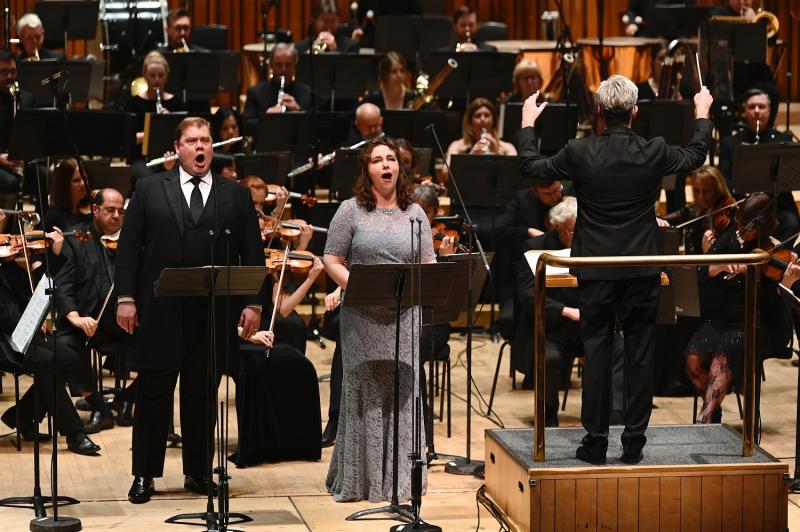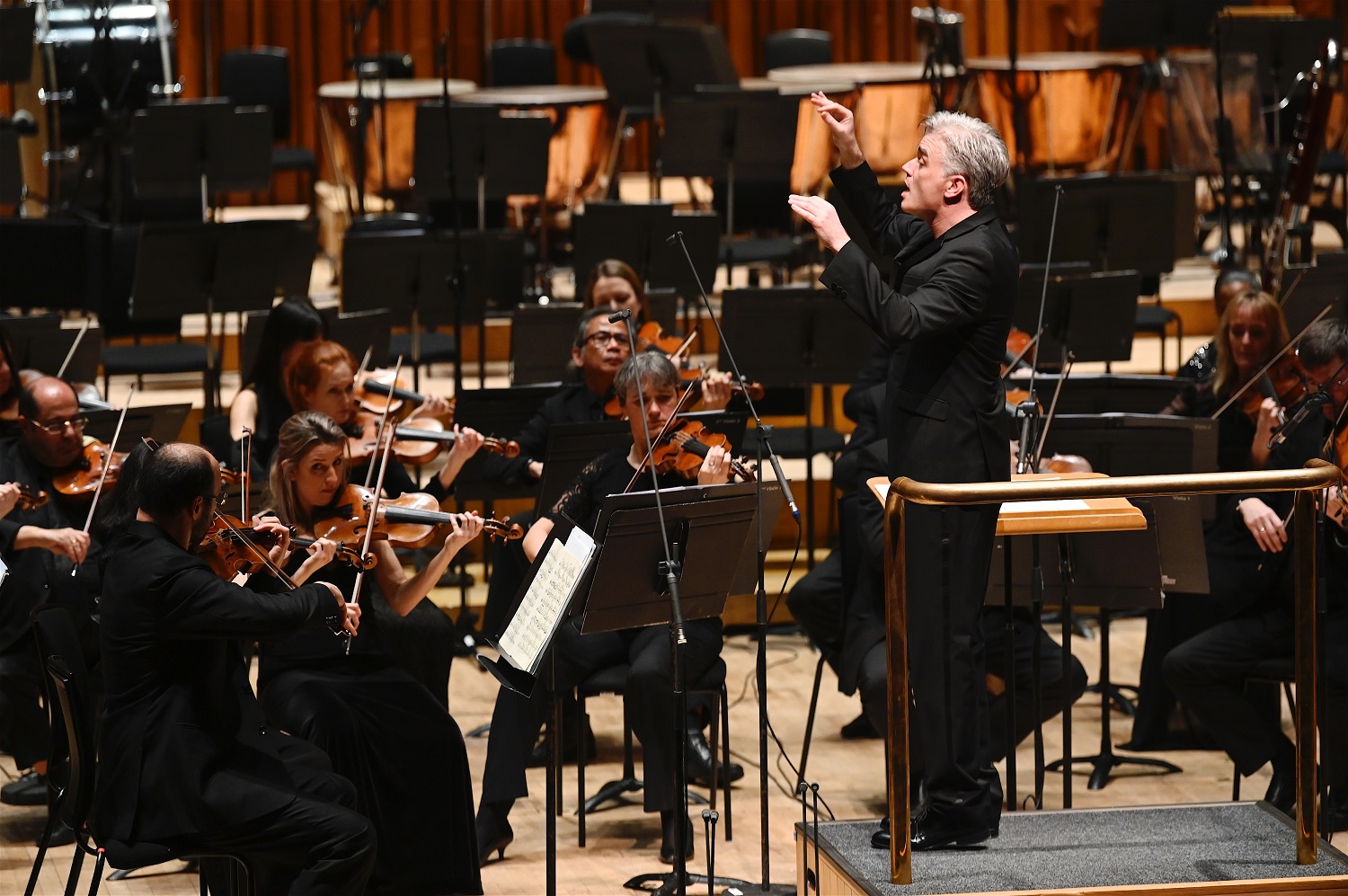Skelton, Rice, BBCSO, Gardner, Barbican review – romanticism’s last stand | reviews, news & interviews
Skelton, Rice, BBCSO, Gardner, Barbican review – romanticism’s last stand
Skelton, Rice, BBCSO, Gardner, Barbican review – romanticism’s last stand
Adventurous programme explores rarely heard works from fin de siècle Vienna

Only a modest audience turned up for this BBC Symphony Orchestra concert, though it was unclear if this was caused by the threat of airborne disease or the inclusion of Schoenberg on the programme. The result was a paradoxical intimacy, with the huge orchestra expressing complex but private emotions from a group of fin de siècle Viennese composers.
Schoenberg’s Verklärte Nacht (originally for string sextet but played here in the composer’s arrangement for string orchestra) is an atmospheric tone poem, based on a poem by Richard Dehmel about a couple reconciling while walking through a wood at night. The BBC Symphony Orchestra strings were on top form here, producing a rich, engaging tone, with weighty but controlled support from the cellos and basses. Conductor Edward Gardner is versatile, but his strengths lie more in propulsion and drama than in the lugubrious tone painting that a score like this requires. He was clearly reluctant to linger on any of Schoenberg’s harmonies, however seductive or complex, but his dramatic shaping brought its own rewards. Schoenberg clearly tells a story here, however abstract, and Gardner emphasised that narrative quality. Phrases were shaped generously, but with the music always propelled towards the next climax.
In an ingenious sleight of programming the Schoenberg was followed by Oskar Fried’s Verklärte Nacht, a setting of the same poem, composed two years later, in 1901. Like Schoenberg, Fried uses rich mid-range textures to evoke the forest setting. His harmonies are less sophisticated than Schoenberg’s, but he makes inventive use of his more limited vocabulary, and his orchestral colouring is expertly applied. The work makes Wagnerian demands on its two vocal soloists, but both mezzo Christine Rice and tenor Stuart Skelton proved up to the task. Rice employs a broad but controlled vibrato, which suits this music perfectly. Skelton brought his full set of Heldentenor skills to the role, which could easily have disappeared under the huge orchestra from a lesser voice.  Franz Lehár’s Fieber (Fever) was the next Viennese oddity. The work, described as a tone poem for tenor and orchestra (though originally with piano accompaniment), tells of a soldier, experiencing a series of lurid visions as he dies on a battlefield. Not the usual fluffy fare we expect from Lehár then. The score is surprisingly Mahlerian, with military marches and tattoos woven into the fabric. But Lehár takes everything too far, and the results are overblown and melodramatic. Fortunately, Stuart Skelton brought some dramatic credibility to proceedings. His rich but nimble voice again proved ideal, as did his ability to carry over a punishingly huge orchestra.
Franz Lehár’s Fieber (Fever) was the next Viennese oddity. The work, described as a tone poem for tenor and orchestra (though originally with piano accompaniment), tells of a soldier, experiencing a series of lurid visions as he dies on a battlefield. Not the usual fluffy fare we expect from Lehár then. The score is surprisingly Mahlerian, with military marches and tattoos woven into the fabric. But Lehár takes everything too far, and the results are overblown and melodramatic. Fortunately, Stuart Skelton brought some dramatic credibility to proceedings. His rich but nimble voice again proved ideal, as did his ability to carry over a punishingly huge orchestra.
Back to Schoenberg for the final work, his 1937 orchestration of Brahms’s First Piano Quartet. The arrangement has always been controversial, for the huge orchestra that Schoenberg employs to convey Brahms’s modest and unprepossessing textures. I’m a believer: The original is early Brahms and the sophistication that the mature Schoenberg brings adds richness and colour. But the work needs guidance from a steady hand, as the huge orchestra can easily become unbalanced. Fortunately, Gardner (pictured above) knew exactly where to take the music. Despite the often bottom heavy orchestration, he kept everything fleet and swift. He made no apologies for Schoenberg’s approach, and the sheer weight of the orchestral sound was an important dimension of his reading. Supply shaped phrases in the first movement brought a muscular rigour to the main themes. Textures in the quieter moments were sometimes a little loose, but Gardner wasn’t fussing over details.
The third movement Andante con molto is the most provocative part of Schoenberg’s arrangement, the delicate textures here scaled up to huge string sonorities to the point of unrecognisability. But Gardner pushed through, giving the music elegant rhythmic shape, and without letting the heavy textures drag. That tension became acute at the opening of the Presto finale, with the swift Hungarian dance initially unsteady on its feet. But Gardner soon regained control, cleanly articulating the distinct tempos for each of the episodes. There is no doubting that this orchestration deserves its controversial reputation, but the tensions that Schoenberg introduces make it an ideal vehicle for a virtuoso conductor, and Edward Gardner shone.
rating
Explore topics
Share this article
The future of Arts Journalism
You can stop theartsdesk.com closing!
We urgently need financing to survive. Our fundraising drive has thus far raised £49,000 but we need to reach £100,000 or we will be forced to close. Please contribute here: https://gofund.me/c3f6033d
And if you can forward this information to anyone who might assist, we’d be grateful.

Subscribe to theartsdesk.com
Thank you for continuing to read our work on theartsdesk.com. For unlimited access to every article in its entirety, including our archive of more than 15,000 pieces, we're asking for £5 per month or £40 per year. We feel it's a very good deal, and hope you do too.
To take a subscription now simply click here.
And if you're looking for that extra gift for a friend or family member, why not treat them to a theartsdesk.com gift subscription?
more Classical music
 Weilerstein, NYO2, Payare / Dueñas, Malofeev, Edinburgh International Festival 2025 review - youthful energy and emotional intensity
Big-boned Prokofiev and Shostakovich, cacophonous López, plus intense violin/piano duo
Weilerstein, NYO2, Payare / Dueñas, Malofeev, Edinburgh International Festival 2025 review - youthful energy and emotional intensity
Big-boned Prokofiev and Shostakovich, cacophonous López, plus intense violin/piano duo
 theartsdesk at the Three Choirs Festival - Passion in the Cathedral
Cantatas new and old, slate quarries to Calvary
theartsdesk at the Three Choirs Festival - Passion in the Cathedral
Cantatas new and old, slate quarries to Calvary
 BBC Proms: Estonian Philharmonic Chamber Choir, Kaljuste review - Arvo Pärt 90th birthday tribute
Stillness and contemplation characterise this well sung late-nighter
BBC Proms: Estonian Philharmonic Chamber Choir, Kaljuste review - Arvo Pärt 90th birthday tribute
Stillness and contemplation characterise this well sung late-nighter
 BBC Proms: Kholodenko, BBCNOW, Otaka review - exhilarating Lutosławski, underwhelming Rachmaninov
Polish composers to the fore in veteran conductor’s farewell
BBC Proms: Kholodenko, BBCNOW, Otaka review - exhilarating Lutosławski, underwhelming Rachmaninov
Polish composers to the fore in veteran conductor’s farewell
 theartsdesk at the Pärnu Music Festival 2025 - Arvo Pärt at 90 flanked by lightness and warmth
Paavo Järvi’s Estonian Festival Orchestra still casts its familiar spell
theartsdesk at the Pärnu Music Festival 2025 - Arvo Pärt at 90 flanked by lightness and warmth
Paavo Järvi’s Estonian Festival Orchestra still casts its familiar spell
 BBC Proms: Batsashvili, BBC Scottish Symphony Orchestra, Ryan Wigglesworth review - grief and glory
Subdued Mozart yields to blazing Bruckner
BBC Proms: Batsashvili, BBC Scottish Symphony Orchestra, Ryan Wigglesworth review - grief and glory
Subdued Mozart yields to blazing Bruckner
 Classical CDs: Hens, Hamburg and handmaids
An unsung French conductor boxed up, plus Argentinian string quartets and baroque keyboard music
Classical CDs: Hens, Hamburg and handmaids
An unsung French conductor boxed up, plus Argentinian string quartets and baroque keyboard music
 BBC Proms: McCarthy, Bournemouth SO, Wigglesworth review - spring-heeled variety
A Ravel concerto and a Walton symphony with depth but huge entertainment value
BBC Proms: McCarthy, Bournemouth SO, Wigglesworth review - spring-heeled variety
A Ravel concerto and a Walton symphony with depth but huge entertainment value
 BBC Proms: First Night, Batiashvili, BBCSO, Oramo review - glorious Vaughan Williams
Spirited festival opener is crowned with little-heard choral epic
BBC Proms: First Night, Batiashvili, BBCSO, Oramo review - glorious Vaughan Williams
Spirited festival opener is crowned with little-heard choral epic
 Interview: Quinteto Astor Piazzolla on playing in London and why Mick Jagger's a fan
Music Director Julián Vat and pianist Matias Feigin compare notes on Piazzolla
Interview: Quinteto Astor Piazzolla on playing in London and why Mick Jagger's a fan
Music Director Julián Vat and pianist Matias Feigin compare notes on Piazzolla
 Classical CDs: Bells, birdsong and braggadocio
British contemporary music, percussive piano concertos and a talented baritone sings Mozart
Classical CDs: Bells, birdsong and braggadocio
British contemporary music, percussive piano concertos and a talented baritone sings Mozart

Add comment